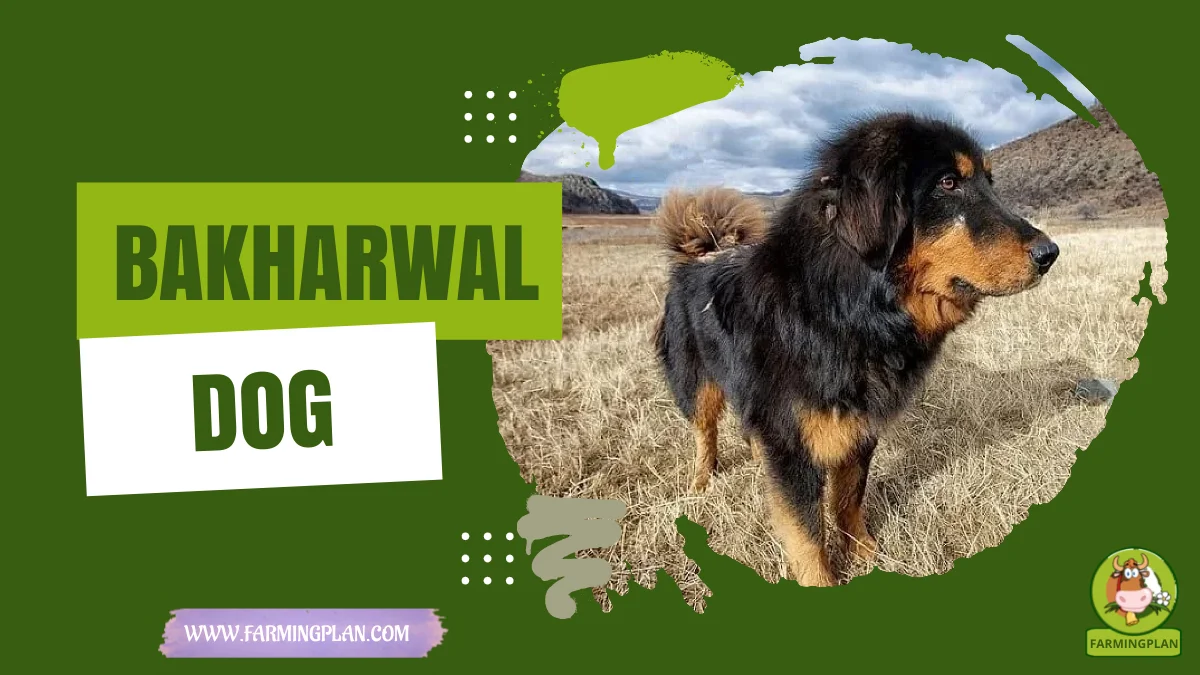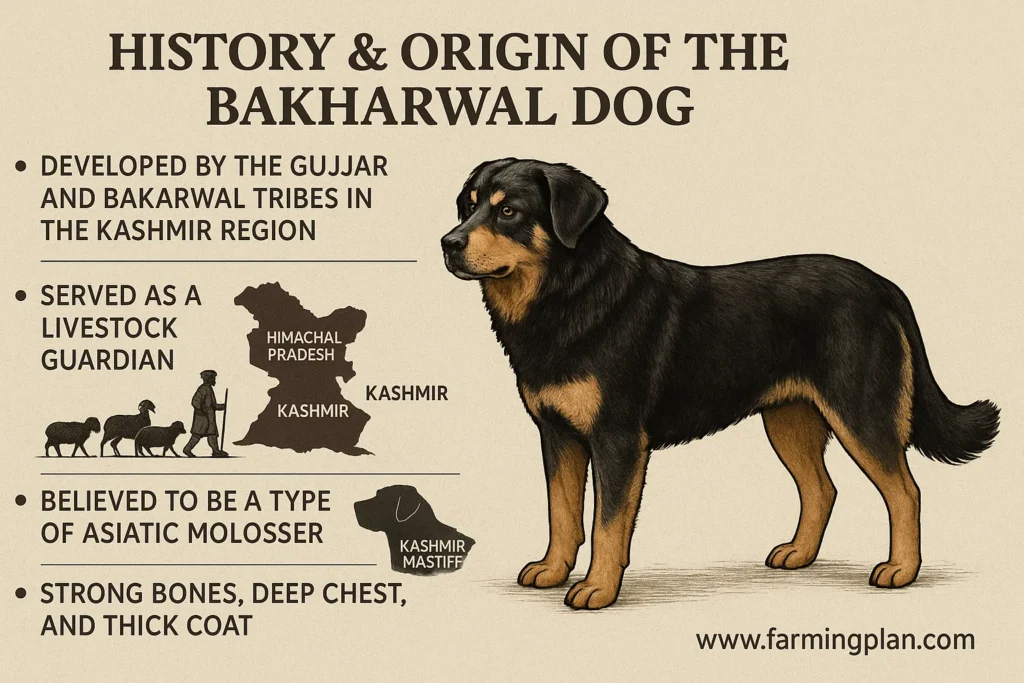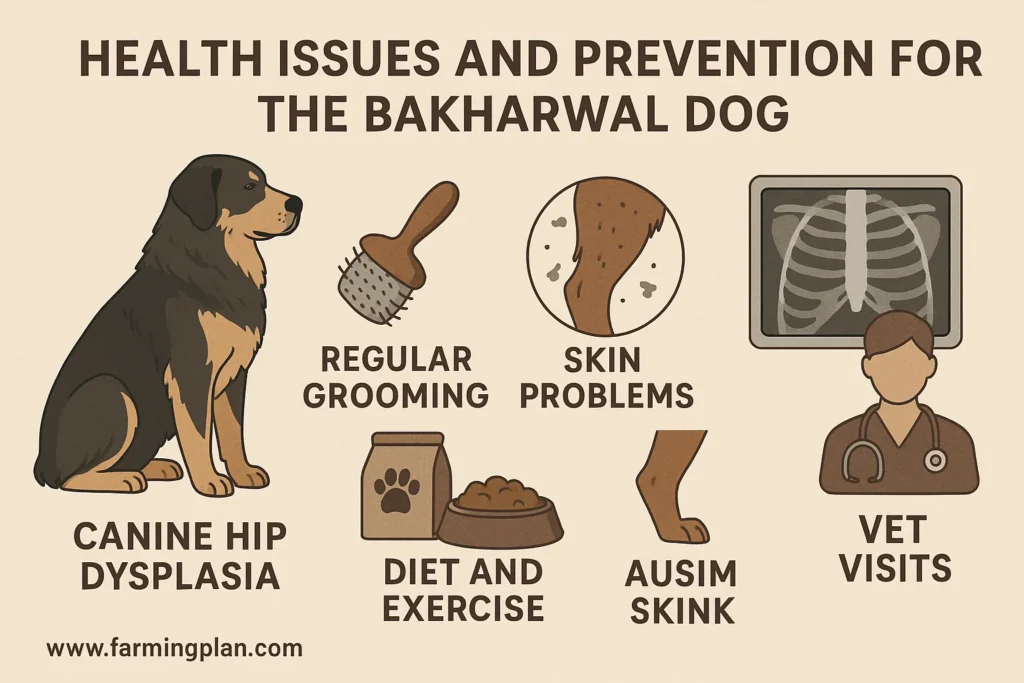The Bakharwal Dog is one of the most ancient and sturdy breeds I’ve ever worked with. Bred for centuries by the Gujjar and Bakarwal tribes of Kashmir, this loyal dog is more than just a guardian—it’s a faithful family member. Strong, protective, and full of character, the Bakharwal is known for watching over flocks, chasing away predators, and sticking close to the people it trusts. This breed’s deep chest, thick double coat, and powerful body make it perfect for mountain life, but it also fits well in farms and large open spaces. Whether you’re a pet lover, a livestock farmer, or just curious about rare breeds, you’ll find this unusual dog as fascinating as mine.

History & Origin of the Bakharwal Dog
The Bakharwal Dog has a story that goes back to ancient times. As a farming specialist, I’ve always admired how this breed has survived through centuries of change. It was initially developed by the Gujjar and Bakarwal tribes in the Kashmir region, where it served as a livestock guardian. These dogs traveled with nomadic herders through the mountains of Kashmir, Himachal Pradesh, and Ladakh, protecting Kashmiri sheep and other domestic animals from attacks by predators. Many experts believe the Bakharwal Dog is a type of Asiatic molosser closely related to the Kashmir Mastiff and other Mastiff breeds of Central Asia.

Its strong bones, deep chest, and thick coat make it ideal for rough terrain and harsh climates. This mountain breed isn’t just tough—it’s part of a glorious breed history that tells us about the bond between humans and dogs since prehistoric times. Sadly, some fear it may become an extinct breed if not protected. That’s why it’s essential to learn more about this rare and original dog breed and to keep its legacy alive.
Characteristics of the Bakharwal Dog
The Bakharwal Dog is truly a sturdy breed with a powerful presence. When I first saw one up close, I noticed its strong body, muscular neck, and proud stance that showed both confidence and loyalty. It has a deep chest, broad head, and strong legs that help it move easily through rocky mountain paths. This intelligent animal has a double-layer coat that protects it in cold weather.
You’ll often see furry coats in colors like black, tan, or piebald coats (white with patches). Its outer coat is coarse, while the entire jacket is thick and weatherproof. These dogs shed seasonally, so owners should brush them often to keep their coats healthy. The average size of a Bakharwal Dog is large.
Males usually stand 24–30 inches tall and weigh around 80–100 pounds. Females are a bit smaller. The litter size ranges from 3 to 7 puppies, and they grow quickly during their early months. Other names, like Bakarwal Mastiff, Kashmir Sheepdog, or Bakharwal Mastiff also know this ancient breed. It’s a beautiful, unusual breed with strength and grace, perfect for guarding and farm life.
Reads More: Welsummer Chicken: Beautiful Layers With Friendly Temperament
Nature and Temperament of the Bakharwal Dog
From my experience, the Bakharwal Dog is one of the most loyal and fearless dogs you’ll ever meet. It was born to guard, and it takes that job seriously. This breed is naturally protective, especially around its family, home, or livestock. That’s why Gaddis, Jats, and Gujjar Bakerwals trust it as a guardian of sheep and animals.
Despite its tough looks, the Bakharwal Dog can be very gentle with people it knows. It’s not aggressive unless it feels there’s a real threat. This intelligent animal is always alert, making it a great watchdog. It doesn’t bark without reason, and it knows how to handle danger calmly and with strength.
Because of its strong guarding instinct, this dog needs firm training and lots of mental exercises. It’s not the best match for small apartments or inactive homes. It needs space, regular exercise, and an owner who can lead with confidence. If you’re patient and consistent, the Bakharwal Dog will become a trustworthy and loving companion. It bonds deeply and becomes more than just a pet—it becomes your protector and friend.
Food and Diet for the Bakharwal Dog
Feeding a Bakharwal Dog the right way keeps it strong, alert, and energetic. This breed comes from the mountains, where its diet has always been simple but powerful. I’ve seen many healthy Bakharwal Dogs raised on a traditional diet passed down by Gujjar and Bakarwal tribes.

Surprisingly, this breed has done well on a vegetarian diet for generations. Many owners feed it a mix of milk, rice, and bread, which is part of the diet of milk and grains they’ve known for ages. Still today, many people also give Bakharwal Dog food that includes high-protein kibble, cooked eggs, and lean meat to boost strength and muscle health. No matter what you choose, always make sure the food is natural, fresh, and balanced.
Avoid feeding your dog sweets, fried food, or anything spicy. These can cause common health issues and harm digestion. Also, remember that puppies and adult dogs have different needs. Bakharwal dog puppies need more protein for growth, while adults need food that supports joints and bones. Proper feeding helps prevent canine health disorders and keeps your dog happy and active.
Tip: “Stick to a steady feeding schedule and clean water supply. Good food leads to a healthy coat and fewer vet visits.”
Usage and Purpose of the Bakharwal Dog
The Bakharwal Dog has always had a clear and powerful purpose—guarding livestock and protecting property. I’ve seen these dogs in action, and let me tell you, they’re fearless when it comes to chasing off predators like wolves, leopards, and even bears. That’s why Gujjar herders and other mountain communities trust them with their Kashmiri sheep and goats.
This breed is not your average pet. It’s a true livestock guardian, bred for tough jobs in hard conditions. From ancient times to today, it has served as a working dog, helping in the rearing of sheep and keeping domestic animals safe. It follows herds across valleys and mountains, watching silently and acting only when needed.
Although it’s rare, some people now keep the Bakharwal Dog as a family protector or watchdog on large properties. It’s not suited for city life or apartments, but it thrives on open farms, rural homes, or even Bakarwal dog kennels with enough space and exercise time. This dog isn’t meant for shows or tricks but for serious work. And when raised right, it never fails to do its job with heart and honor.
Reads More: Pekin Chicken: Charming Bantams That Make Perfect Backyard Buddies
Special Features of the Bakharwal Dog
The Bakharwal Dog’s mix of beauty, power, and ancient roots makes it stand out. From my years working with this breed, I can tell you that it’s no ordinary dog. It’s a glorious breed full of rare, unique qualities that go far beyond looks. First, its double coat is one of its best defenses. The thick outer coat and soft underlayer protect it from snow, rain, and extreme cold.
It also helps fight off bites during attacks from predators. Some dogs even have rare piebald coats, which are white with colorful patches—absolutely stunning. Another special trait is its deep chest and muscular neck. These features give it strength and endurance to climb steep hills, run long distances, and face down wild threats. This dog is built like a mountain warrior, yet it can stay calm and quiet when needed.
One of the most fascinating things is how this ancient breed has survived without needing modern breeding changes. It still holds the original traits of the molosser breed and Asiatic mollusar dogs. That makes it one of the few original dog breeds left in the region. If you’re looking for a rare, healthy breed with centuries of loyalty in its blood, the Bakharwal Dog is a true gem.
“Strong Roots Build Fierce Guardians—The Bakharwal Dog Protects With Heart And Courage.”
Health Issues and Prevention for the Bakharwal Dog
From my experience, the Bakharwal Dog is generally a healthy breed, but like all dogs, it faces some common health issues you should watch for. One of the major concerns is canine hip dysplasia, a condition affecting the hips and causing pain or difficulty moving. Because these dogs are large and muscular, maintaining optimal dog health with regular checkups is key.

Another concern is the risk of skin problems caused by their thick double coat, especially if grooming is skipped. Regular brushing helps prevent mats and keeps the coat of hair clean and healthy. Bathing should be done carefully to avoid stripping natural oils. It’s important to monitor your dog’s diet, exercise, and health care routines.
I always recommend Chest X-rays for early detection of joint issues in larger breeds like the Bakharwal. Also, timely visits to the vet can prevent many canine health disorders from getting worse. Keep an eye on any unusual behavior like limping, excessive scratching, or loss of appetite. Early treatment training and good veterinary care help keep your Bakharwal dog active and strong for many years.
Step-by-Step Care Guide for Your Bakharwal Dog
Raising a Bakharwal Dog takes time, patience, and the right approach. Here’s my personal step-by-step guide to help you care for this amazing breed:
Prepare the Space
Create a large, secure area for your dog to roam freely. These dogs need plenty of room to exercise and explore, just like their life in the mountains. A Bakarwal dog kennel should be spacious and well-ventilated.
Choose the Right Diet
Feed your dog a balanced diet. Start with a mix of high-quality Bakharwal dog food, fresh vegetables, and lean proteins. For puppies, include milk and soft foods to help with growth. Avoid processed or spicy food.
Regular Exercise
Provide sufficient exercise every day. This breed thrives on long walks, running, and mental challenges. Exercise helps keep their muscular neck and deep chest strong and healthy.
Training and Socialization
Start firm training early. Use positive reinforcement and be consistent. Teach basic commands and introduce your dog to people and other animals to build good social skills.
Grooming Routine
Brush your Bakharwal’s double coat at least twice a week. This prevents matting and removes loose fur. Bathe them occasionally, but don’t overdo it to protect their natural oils.
Health Checks
Schedule regular vet visits for vaccinations, Chest X-rays, and health screenings. Watch for signs of canine hip dysplasia and other common health issues.
Protection from Predators
If you’re using your dog as a livestock guardian, make sure the animals are protected during vulnerable times like night or birth. The Bakharwal is naturally protective but benefits from support.
Expert Tips and Best Practices for Bakharwal Dog Owners
From my years working with the Bakharwal Dog, I’ve learned a few secrets that can help you raise a happy and strong companion. First, always give your dog lots of exercise—this breed needs regular exercise to stay healthy and avoid boredom. Mental training is just as important; challenge your dog with tasks like guarding drills or obedience games. Be consistent with firm training from puppyhood.
The Bakharwal is an intelligent animal, but it respects clear leadership. Early socialization helps prevent aggression toward strangers while keeping their natural guarding instincts sharp. Nutrition matters a lot. Stick to a balanced, natural diet and avoid overfeeding. This helps prevent canine health disorders and keeps your dog’s coat of hair shiny and strong. If you live in mountainous or rural areas, make sure your dog gets sufficient time outdoors. This breed was bred for the cold, so they thrive with fresh air and wide open spaces.
Tip: “Regular vet checkups and a good diet make all the difference. Catch health issues early to keep your Bakharwal strong for years.”
Where to Buy a Bakharwal Dog
Finding a healthy Bakharwal Dog or Bakharwal dog puppies for sale requires careful research. Because this breed is rare and highly valued, it’s essential to buy from a trusted source. Look for reputable Bakharwal dog kennels that specialize in this ancient breed. Many breeders are located in Kashmir, Himachal Pradesh, and Ladakh, where the breed has its roots.
These kennels often provide health guarantees and information on the dog’s lineage. Prices for a Bakharwal dog puppy can vary depending on the bloodline and breeder reputation. Typically, the Bakharwal dog price reflects the breed’s strength, size, and health care history.
If you are serious about getting a Bakharwal, connect with local Gujjar communities or livestock owners who raise these dogs. They can offer valuable advice or direct you to reliable breeders. Before purchasing, visit the kennel, check the living conditions, and ask for health records. This helps ensure you bring home a strong, healthy, and well-cared-for Bakharwal dog.
FAQs
What is the Bakharwal Dog’s origin?
The Bakharwal Dog comes from the mountainous regions of Kashmir, Himachal Pradesh, and Ladakh. It has served for centuries as a livestock guardian for the Gujjar and Bakarwal tribes.
How big does a Bakharwal Dog get?
This breed is sturdy and muscular, with an average size ranging from medium to large. Their deep chest and strong build make them excellent for guarding sheep and livestock.
What kind of diet is best for a Bakharwal Dog?
Traditionally, they thrive on a simple diet of milk, grains, and fresh food. Today, balanced dog food combined with fresh proteins and vegetables works best for their health.
Is the Bakharwal Dog good with families?
Yes, when properly trained and socialized, Bakharwal Dogs can be loyal family protectors. However, they are best suited for homes with ample space and active lifestyles.
Where can I buy a healthy Bakharwal Dog puppy?
Look for reputable breeders or kennels in Kashmir, Himachal, or Ladakh. Connecting with local Gujjar herders can also help you find healthy puppies with strong bloodlines.
Conclusion
From my experience as a farming specialist, the Bakharwal Dog stands out as a powerful, intelligent, and ancient breed with a rich history rooted in the mountainous regions of Kashmir and Central Asia. This sturdy livestock guardian has served the Gujjar and Bakarwal tribes for centuries, protecting sheep and other animals from predators with unmatched loyalty and strength. Caring for a Bakharwal requires a balanced diet, regular exercise, and firm training to maintain its health and temperament. Its unique double coat and muscular build equip it for harsh climates and demanding work. While this breed thrives in rural, open spaces, it can also become a loyal family protector when raised with care and respect.
